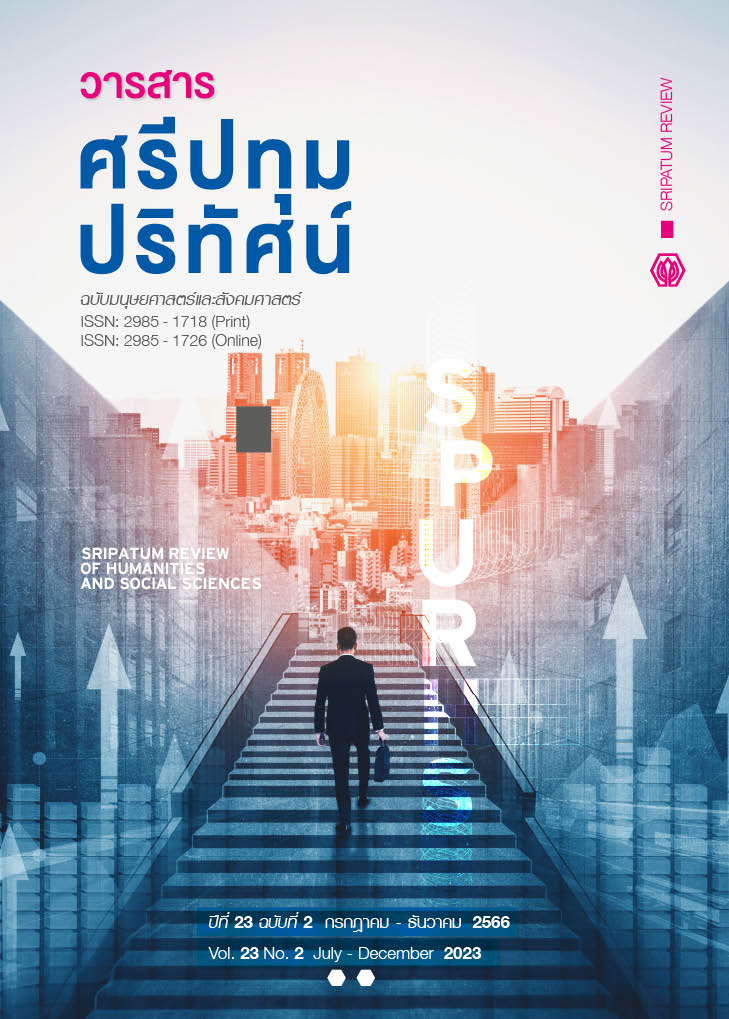Using Microlearning to Develop Chinese Communication Skills of Primary School Students
Main Article Content
Abstract
The study aims (1) to develop micro-learning media that can be applied to Chinese speech for learners, (2) to compare student communication skills between the experiment group and the control group, and (3) to evaluate the students' attitude toward using microlearning to train Chinese speech in children. The total sample of 100 students (two classes) for this experiment was from the fifth grade of Ronghu Public Primary School in Guilin, China. The research instruments included a questionnaire on students' attitudes toward microlearning teaching and assessing students' communication skills after microlearning lessons. The statistics involved in the experiment were mean, S.D., t-test, and ANOVA. Random and control variables were extracted to ensure the reliability of the experimental data. The research found that (1) the teaching content and teaching video designed through microlearning media received high-quality evaluations from five experts, with a mean score of 4.43, (2) the results of the communication ability of students in the experimental group were higher than those of the traditional group, and (3) a survey of students after training with microlearning showed that there was a course in which students had a strong interest in microlearning and a very positive attitude towards learning.
Article Details

This work is licensed under a Creative Commons Attribution-NonCommercial-NoDerivatives 4.0 International License.
1. กองบรรณาธิการสงวนสิทธิ์ในการพิจารณาและตัดสินการตีพิมพ์บทความในวารสาร
2. บทความทุกเรื่องจะได้รับการตรวจสอบทางวิชาการโดยผู้ทรงคุณวุฒิ แต่ข้อความและเนื้อหาในบทความที่ตีพิมพ์เป็นความรับผิดชอบของผู้เขียนแต่เพียงผู้เดียว มิใช่ความคิดเห็นและความรับผิดชอบของมหาวิทยาลัยศรีปทุม
3. การคัดลอกอ้างอิงต้องดำเนินการตามการปฏิบัติในหมู่นักวิชาการโดยทั่วไป และสอดคล้องกับกฎหมายที่เกี่ยวข้อง
References
Akbar, Z., Khan, R. A., Khan, H. F., & Yasmeen, R. (2023). Development and validation of an instrument to measure the Micro-Learning Environment of Students (MLEM). BMC Medical Education, 23(1). https://doi.org/10.1186/s12909-023-04381-3
Autila, R., Syafar, D. N., & Yulmiati, Y. (2023). Students’ attitude toward e-learning during the COVID-19 pandemic at the informatics department of Universitas Pgri Sumatera Barat. Jurnal Ilmiah Mandala Education, 9(1), 1-8. doi:10.58258/jime.v9i1.4072.
Darma, P. S., & Supriyanto, A. S. (2017). The Effect of Compensation on Satisfaction and Employee Performance. Management and Economics Journal, 1(1), 69-78.
Díaz-Millón, M., Rivera-Trigueros, I., & Gutiérrez-Artacho, J. (2023). Student satisfaction with a micro-learning approach in distance translation and interpreting training: an empirical investigation. The Interpreter and Translator Trainer, 17(3), 434-453. doi:10.1080/1750399X.2023.2237322.
Grant, M. M. (2019). Difficulties in defining mobile learning: Analysis, design characteristics, and implications. Educational Technology Research and Development, 67(2), 361-388.
Horst, R., Naraghi-Taghi-Off, R., Rau, L., and Dörner, R. (2020). Bite-Sized Virtual Reality Learning Applications: A Pattern-Based Immersive Authoring Environment. J. Univers. Comput. Sci., 26(8), 947-971.
Hug, T. (2005). Microlearning: a new pedagogical challenge. Innsbruck: Innsbruck University Press.
Kossen, C., and Ooi, C. Y. (2021). Trialing micro-learning design to increase engagement in online courses. Asian Association of Open Universities Journal, 16(3), 299–310.
Leong, K., Sung, A., Au, D., and Blanchard, C. (2021). A review of the trend of microlearning. Journal of Work-Applied Management, 13(1), 88-102.
Liu, X. (2023). Investigation on the Current Situation and Response Methods of Oral Communication Teaching in Primary School Chinese. New Curriculum Teaching (Digital Edition), (09), 58-59.
Ma, N., Zhao, F., Zhou, P., He, J., & Du, L. (2021). Knowledge map-based online micro-learning: impacts on learning engagement, knowledge structure, and learning performance of in-service teachers. Interactive Learning Environments, 31, 2751 - 2766.
Mantle-Bromley, C. (1995). Positive attitudes and realistic beliefs: Links to proficiency. The Modern Language Journal, 79(3), 372-386.
Mori, Y. (1999). Epistemological beliefs and language learning beliefs: What do language learners believe about their learning?. Language Learning, 49(3), 377-415.
Robbins, S. P., & Judge, T. A. (2016). Organizational Behavior (16th ed.). London: Pearson Publishing.
Robles, H., Jimeno, M., Villalba, K., Mardini, I., Viloria-Nuñez, C., & Florian, W. (2023). Design of a micro-learning framework and mobile application using design-based research. PeerJ Computer Science, 9, e1223. doi: 10.7717/peerj-cs.1223
Sabah, N. M. (2013). Students’ attitude and motivation towards e-learning. Proceedings of The First International Conference on Applied Sciences Gaza-Palestine, Deir El-balah, Palestine.
Sakata, N. (2022). Is learner-centred pedagogy associated with pupils’ positive attitudes towards learning? The case of Tanzania. Compare: A Journal of Comparative and International Education, 53, 1373 - 1391.
Sozmen, E. Y. (2022). Perspective on pros and cons of microlearning in health education. Essays in Biochemistry, 66(1), 39-44.
Sun, L., Hu, L., Yang, W., Zhou, D., & Wang, X. (2020). STEM learning attitude predicts computational thinking skills among primary school students. J. Comput. Assist. Learn., 37, 346-358.
Younis, B.K. (2017). The Effects of Scientific Inquiry Simulations on Students’ Higher Order Thinking Skills of Chemical Reaction and Attitude towards Chemistry. American Journal of Educational Research, 5, 1158-1161.


